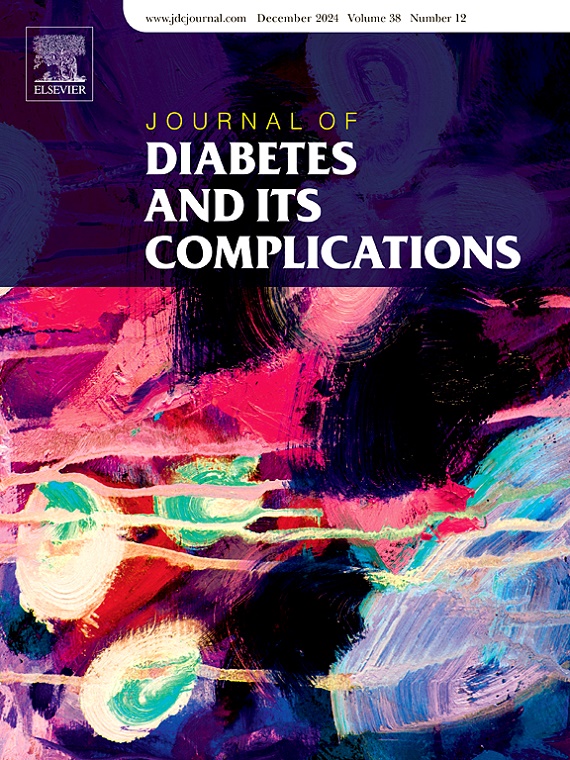Urogenital side effects in male subjects with type 2 diabetes treated with SGLT-2 inhibitors: A single centre, longitudinal observation
IF 3.1
3区 医学
Q3 ENDOCRINOLOGY & METABOLISM
引用次数: 0
Abstract
Objective
SGLT-2 inhibitors (SGLT-2i) provide good glycaemic control and weight loss, ensuring clinically relevant cardiorenal benefits in subjects with and without type 2 diabetes (T2D); however, their use is related to an enhanced risk of urogenital infections, mainly in female subjects. We performed a prospective observation to assess incidence of urogenital complications in male sex new users of gliflozins.
Subjects and methods
In the 2021–2023 years, solely based on clinical indication, we started such therapy in 272 male T2D subjects; follow up visits were performed after about 1 year.
Results
At follow up, 90 subjects had discontinued SGLT-2i; 36 of them (40 %) due to onset of urogenital symptoms. We observed 6 cases of phimosis. Subjects who discontinued the treatment due to these side effects had a higher BMI and a better eGFR at baseline and they were less frequently treated with DPP-IV inhibitors.
Conclusions
A proper evaluation of the patient's phenotype might be useful in identifying subjects less prone to develop side effects driving SGLT-2i discontinuation; the combined use of SGLT-2i and DPP-IV inhibitors appears to be associated to a better long-term compliance to therapy in men.
接受 SGLT-2 抑制剂治疗的男性 2 型糖尿病患者的泌尿生殖系统副作用:单中心纵向观察
目的:glt -2抑制剂(SGLT-2i)提供良好的血糖控制和体重减轻,确保患有和非2型糖尿病(T2D)的受试者具有临床相关的心肾益处;然而,它们的使用与泌尿生殖器感染的风险增加有关,主要是在女性受试者中。我们进行了一项前瞻性观察,以评估格列净男性新使用者泌尿生殖系统并发症的发生率。在2021-2023年间,仅根据临床指征,我们在272名男性T2D患者中开始了这种治疗;约1年后进行随访。结果随访时,90例患者停用SGLT-2i;其中36例(40%)是由泌尿生殖系统症状引起的。我们观察到包茎6例。由于这些副作用而停止治疗的受试者在基线时具有更高的BMI和更好的eGFR,并且他们较少使用DPP-IV抑制剂治疗。结论对患者的表型进行适当的评估可能有助于确定不太容易发生导致SGLT-2i停药的副作用的受试者;联合使用SGLT-2i和DPP-IV抑制剂似乎与男性更好的长期治疗依从性有关。
本文章由计算机程序翻译,如有差异,请以英文原文为准。
求助全文
约1分钟内获得全文
求助全文
来源期刊

Journal of diabetes and its complications
医学-内分泌学与代谢
CiteScore
5.90
自引率
3.30%
发文量
153
审稿时长
16 days
期刊介绍:
Journal of Diabetes and Its Complications (JDC) is a journal for health care practitioners and researchers, that publishes original research about the pathogenesis, diagnosis and management of diabetes mellitus and its complications. JDC also publishes articles on physiological and molecular aspects of glucose homeostasis.
The primary purpose of JDC is to act as a source of information usable by diabetes practitioners and researchers to increase their knowledge about mechanisms of diabetes and complications development, and promote better management of people with diabetes who are at risk for those complications.
Manuscripts submitted to JDC can report any aspect of basic, translational or clinical research as well as epidemiology. Topics can range broadly from early prediabetes to late-stage complicated diabetes. Topics relevant to basic/translational reports include pancreatic islet dysfunction and insulin resistance, altered adipose tissue function in diabetes, altered neuronal control of glucose homeostasis and mechanisms of drug action. Topics relevant to diabetic complications include diabetic retinopathy, neuropathy and nephropathy; peripheral vascular disease and coronary heart disease; gastrointestinal disorders, renal failure and impotence; and hypertension and hyperlipidemia.
 求助内容:
求助内容: 应助结果提醒方式:
应助结果提醒方式:


